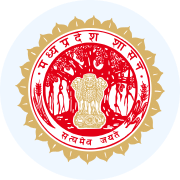Madhya Pradesh: Migration | Course for MPPSC Preparation - MPPSC (Madhya Pradesh) PDF Download
Introduction
Madhya Pradesh is large state in central India (second- largest in the country) located in the geographic heart of India, between latitude 21.2°N-26.87°N and longitude 74°02′-82°49′ E, retains landmarks from eras throughout Indian history.Nicknamed the “heart of India” due to its geographical location in India. With over 75 million inhabitants, it is the 5thlargest state in India by population. It borders the state of Uttar Pradesh in the northeast, Chhattisgarh to the southeast, Maharastra to the south, Rajasthan to the northwest and Gujarat to the west. The state is fully landlocked. Total area of state is 308,252 km2 .
As per details from Census 2011, Madhya Pradesh has population of 7.27 Crores, an increase from 6.03Crore in 2001. Density of state is 236 per sq km which is lower than national average 382 per sq km. The population growth in this decade was 20.35 percent . Total population of Madhya Pradesh as per 2011 census is 72,626,809 of which male and female are 37,612,306 and 35,014,503 respectively. In 2001, total population was 60,348,023 in which males were 31,443,652 while females were 28,904,371. The population of Madhya Pradesh forms 6.00 % of India in 2011 while the figure was 5.87 percent in 2001.
The poor over the last five years as new opportunities in urban areas have reduced the uncertainty of finding work, wages have increased and the dependence on contractors has declined. Furthermore, migration is attracting more women and upper castes as traditional restrictions related to manual work break down. Migration has brought greater returns to those with skills or strong social networks. Others, relying on contractors or facing discrimination, have not benefited as much. Nevertheless, migration is viewed by the poor as a strategy for improving household well-being. Migration has reduced borrowing for consumption, improved debt repayment capacity and given migrants greater confidence and bargaining power.
Internal, seasonal migrations act as a ‘safety valve’ among the poorest communities, more often than not critical to the livelihoods of the most socially and economically vulnerable. Those belong in majority to tribal communities, Scheduled Castes and Other Backward Classes.
- Madhya Pradesh:
- Total Population 60,348,023
- Total in migration 2,305,999
- % of population 3.8
- Share of total migrants4.8
Reasons for Migration
- Land Grabbing: When it comes to land rights, many tribals in Madhya Pradesh got it years ago. But they failed to get real ownership as they are not allowed to cultivate their own lands.The forest department also acts as the enemy of the tribals by denying them the right to cultivate their lands.Denied land rights, tribals are either migrating to other places in search of jobs or are becoming daily wage labourers.Data from the rural development ministry and the Planning Commission reveal that large chunks of lands continue to be alienated from tribals in Madhya Pradesh (1.58 lakh acres). To address this problem , in January 2016 theMadhya Pradesh government conferred habitat right upon the Baigas a primitive tribe, to right the wrong meted out to them for centuries.
- To find new opportunities in urban areas: The Opportunities for poor over years have reduced to find work. Hence the uncertainty and poverty increased in certain tribes.
- Discrimination against backward classes like SC/ST/OBC etc. force them to shift to other place in hope of getting better lifestyle.
- Draught in MP forces SAHARIA tribe to migrate.
- Traditional reasons: employment, education, family moved, marriage
- Modern reasons emerged after liberalization: business, drought( Saharia community) and other natural calamities.
Scenarios (2016-2020)
- Migration in future in Madhya Pradesh will follow following trend: Widening the gap between the developmental paradigm and tribal poverty reduction- tribal poverty reduction is still not prioritised over the competing agenda for Madhya Pradesh and Rajasthan’s economic development. Progress is comparatively slower in tribal areas, where, in addition to mutual mistrust (STs-government), the mechanisation backlash continues to challenge STs’ access to seasonal job opportunities, a determinant means for households to buy food. In addition, and despite existing law on land rights, STs’ livelihoods are further endangered by 2020. Overall, the absence of any real protection from authorities and tribal communities, lack of bargaining power, maintain STs’ relative dependence on contractors by 2020 and hence migration will continue from these communities.
- Bridging the gap, sustained traditional migrations in an improved overall context: tribal poverty slowly reducing in Madhya Pradesh because of government’s social security schemes like MGNREGA and National Food Security Act. Hence migration is expected to decrease in future for traditional reasons like poverty, food insecurity , draught etc.
- India’s development ‘now and everywhere’ hardly means ‘for everyone’: The accelerated impact of climate change is perceptible, causing huge loss to agricultural crops, and thereby forcing more families to migrate outside well-established migratory patterns considering tribal communities’ vulnerability to external shocks. Children and women are the most affected, suffering from deprivation during migrations impacting their health condition. Further the benefit of higher rate of development of India is not reaching to weaker section of society like SC/ST/OBC and women.
- Considering the key socio-economic drivers at play, tribal migrations are likely to continue accelerating by 2020. Hence to contain migration;, civil society actors could find in the preparatory phase preceding migrations an interesting window for action in addition to government measures.
- As part of the existing strategies deployed by migrating families, some reported gathering a few packets of Take-Home Rations (THR) from Anganwadi Centres (AWCs), as well as pain killers and basic medicine. Activities targeting care practices awareness, contextualized to the living conditions on work sites and targeting the adults in charge of the temporary settlement, might also constitute an impactful trigger while operating in the source area.
|
67 videos|98 docs
|

|
Explore Courses for MPPSC (Madhya Pradesh) exam
|

|
















